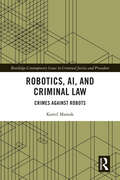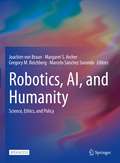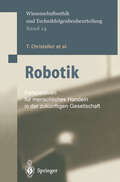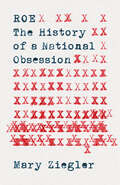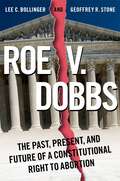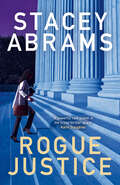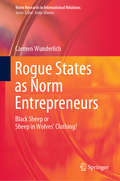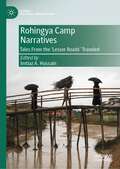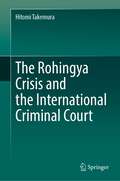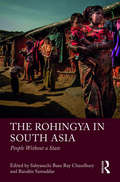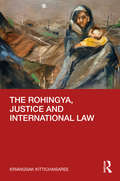- Table View
- List View
Robotics, AI and Criminal Law: Crimes Against Robots (Routledge Contemporary Issues in Criminal Justice and Procedure)
by Kamil MamakThis book offers a phenomenological perspective on the criminal law debate on robots. Today, robots are protected in some form by criminal law. A robot is a person’s property and is protected as property. This book presents the different rationale for protecting robots beyond the property justification based on the phenomenology of human-robot interactions. By focusing on robots that have bodies and act in the physical world in social contexts, the work provides an assessment of the issues that emerge from human interaction with robots, going beyond perspectives focused solely on artificial intelligence (AI). Here, a phenomenological approach does not replace ontological concerns, but complements them. The book addresses the following key areas: Regulation of robots and AI; Ethics of AI and robotics; and philosophy of criminal law. It will be of interest to researchers and academics working in the areas of Criminal Law, Technology and Law and Legal Philosophy.
Robotics, AI, and Humanity: Science, Ethics, and Policy
by Margaret S. Archer Gregory M. Reichberg Joachim Von Braun Marcelo Sánchez SorondoThis open access book examines recent advances in how artificial intelligence (AI) and robotics have elicited widespread debate over their benefits and drawbacks for humanity. The emergent technologies have for instance implications within medicine and health care, employment, transport, manufacturing, agriculture, and armed conflict. While there has been considerable attention devoted to robotics/AI applications in each of these domains, a fuller picture of their connections and the possible consequences for our shared humanity seems needed. This volume covers multidisciplinary research, examines current research frontiers in AI/robotics and likely impacts on societal well-being, human – robot relationships, as well as the opportunities and risks for sustainable development and peace. The attendant ethical and religious dimensions of these technologies are addressed and implications for regulatory policies on the use and future development of AI/robotics technologies are elaborated.
Robotics, AI and the Future of Law (Perspectives in Law, Business and Innovation)
by Marcelo Corrales Mark Fenwick Nikolaus ForgóArtificial intelligence and related technologies are changing both the law and the legal profession. In particular, technological advances in fields ranging from machine learning to more advanced robots, including sensors, virtual realities, algorithms, bots, drones, self-driving cars, and more sophisticated “human-like” robots are creating new and previously unimagined challenges for regulators. These advances also give rise to new opportunities for legal professionals to make efficiency gains in the delivery of legal services. With the exponential growth of such technologies, radical disruption seems likely to accelerate in the near future.This collection brings together a series of contributions by leading scholars in the newly emerging field of artificial intelligence, robotics, and the law. The aim of the book is to enrich legal debates on the social meaning and impact of this type of technology. The distinctive feature of the contributions presented in this edition is that they address the impact of these technological developments in a number of different fields of law and from the perspective of diverse jurisdictions. Moreover, the authors utilize insights from multiple related disciplines, in particular social theory and philosophy, in order to better understand and address the legal challenges created by AI. Therefore, the book will contribute to interdisciplinary debates on disruptive new AI technologies and the law.
Robotics and Well-Being: The Role Of Ethics And Standardization (Intelligent Systems, Control and Automation: Science and Engineering #95)
by Maria Isabel Aldinhas Ferreira João Silva Sequeira Gurvinder Singh Virk Mohammad Osman Tokhi Endre E. KadarThis book highlights some of the most pressing safety, ethical, legal and societal issues related to the diverse contexts in which robotic technologies apply. Focusing on the essential concept of well-being, it addresses topics that are fundamental not only for research, but also for industry and end-users, discussing the challenges in a wide variety of applications, including domestic robots, autonomous manufacturing, personal care robots and drones.
Robotik: Perspektiven für menschliches Handeln in der zukünftigen Gesellschaft (Ethics of Science and Technology Assessment #14)
by T. Christaller M. Decker J.-M. Gilsbach G. Hirzinger K. Lauterbach E. Schweighofer Gerhard Schweitzer D. SturmaRobots, Healthcare, and the Law: Regulating Automation in Personal Care (Routledge Research in the Law of Emerging Technologies)
by Eduard Fosch-VillarongaThe integration of robotic systems and artificial intelligence into healthcare settings is accelerating. As these technological developments interact socially with children, the elderly, or the disabled, they may raise concerns besides mere physical safety; concerns that include data protection, inappropriate use of emotions, invasion of privacy, autonomy suppression, decrease in human interaction, and cognitive safety. Given the novelty of these technologies and the uncertainties surrounding the impact of care automation, it is unclear how the law should respond. This book investigates the legal and regulatory implications of the growing use of personal care robots for healthcare purposes. It explores the interplay between various aspects of the law, including safety, data protection, responsibility, transparency, autonomy, and dignity; and it examines different robotic and AI systems, such as social therapy robots, physical assistant robots for rehabilitation, and wheeled passenger carriers. Highlighting specific problems and challenges in regulating complex cyber-physical systems in concrete healthcare applications, it critically assesses the adequacy of current industry standards and emerging regulatory initiatives for robots and AI. After analyzing the potential legal and ethical issues associated with personal care robots, it concludes that the primarily principle-based approach of recent law and robotics studies is too abstract to be as effective as required by the personal care context. Instead, it recommends bridging the gap between general legal principles and their applicability in concrete robotic and AI technologies with a risk-based approach using impact assessments. As the first book to compile both legal and regulatory aspects of personal care robots, this book will be a valuable addition to the literature on robotics, artificial intelligence, human–robot interaction, law, and philosophy of technology.
Robots, Healthcare, and the Law: Regulating Automation in Personal Care (Routledge Research in the Law of Emerging Technologies)
by Eduard Fosch-VillarongaThe integration of robotic systems and artificial intelligence into healthcare settings is accelerating. As these technological developments interact socially with children, the elderly, or the disabled, they may raise concerns besides mere physical safety; concerns that include data protection, inappropriate use of emotions, invasion of privacy, autonomy suppression, decrease in human interaction, and cognitive safety. Given the novelty of these technologies and the uncertainties surrounding the impact of care automation, it is unclear how the law should respond. This book investigates the legal and regulatory implications of the growing use of personal care robots for healthcare purposes. It explores the interplay between various aspects of the law, including safety, data protection, responsibility, transparency, autonomy, and dignity; and it examines different robotic and AI systems, such as social therapy robots, physical assistant robots for rehabilitation, and wheeled passenger carriers. Highlighting specific problems and challenges in regulating complex cyber-physical systems in concrete healthcare applications, it critically assesses the adequacy of current industry standards and emerging regulatory initiatives for robots and AI. After analyzing the potential legal and ethical issues associated with personal care robots, it concludes that the primarily principle-based approach of recent law and robotics studies is too abstract to be as effective as required by the personal care context. Instead, it recommends bridging the gap between general legal principles and their applicability in concrete robotic and AI technologies with a risk-based approach using impact assessments. As the first book to compile both legal and regulatory aspects of personal care robots, this book will be a valuable addition to the literature on robotics, artificial intelligence, human–robot interaction, law, and philosophy of technology.
The Robust Demands of the Good: Ethics with Attachment, Virtue, and Respect (Uehiro Series in Practical Ethics)
by Philip PettitPhilip Pettit offers a new insight into moral psychology. He shows that attachments such as love, and certain virtues such as honesty, require not only their characteristic positive behaviours in the actual world (i.e. as things are), but preservation of those characteristic behaviours across a range of counterfactual scenarios in which things are different from how they actually are. The counterfactual 'robustness', in this sense, of these behaviours is thus part of our very conception of these attachments and these virtues. Pettit shows that attachment, virtues, and respect all conform to a similar conceptual geography. He explores the implications of this idea for key moral issues, such as the doctrine of double effect and the distinction between doing and allowing. He articulates and argues against an assumption, which he calls 'moral behaviourism,' which permeates contemporary ethics.
The Robust Demands of the Good: Ethics with Attachment, Virtue, and Respect (Uehiro Series in Practical Ethics)
by Philip PettitPhilip Pettit offers a new insight into moral psychology. He shows that attachments such as love, and certain virtues such as honesty, require not only their characteristic positive behaviours in the actual world (i.e. as things are), but preservation of those characteristic behaviours across a range of counterfactual scenarios in which things are different from how they actually are. The counterfactual 'robustness', in this sense, of these behaviours is thus part of our very conception of these attachments and these virtues. Pettit shows that attachment, virtues, and respect all conform to a similar conceptual geography. He explores the implications of this idea for key moral issues, such as the doctrine of double effect and the distinction between doing and allowing. He articulates and argues against an assumption, which he calls 'moral behaviourism,' which permeates contemporary ethics.
Robust Ethics: The Metaphysics and Epistemology of Godless Normative Realism
by Erik J. WielenbergErik J. Wielenberg draws on recent work in analytic philosophy and empirical moral psychology to defend non-theistic robust normative realism and develop an empirically-grounded account of human moral knowledge. Non-theistic robust normative realism has it that there are objective, non-natural, sui generis ethical features of the universe that do not depend on God for their existence. The early chapters of the book address various challenges to the intelligibility and plausibility of the claim that irreducible ethical features of things supervene on their non-ethical features as well as challenges from defenders of theistic ethics who argue that objective morality requires a theistic foundation. Later chapters develop an account of moral knowledge and answer various recent purported debunkings of morality, including those based on scientific research into the nature of the proximate causes of human moral beliefs as well as those based on proposed evolutionary explanations of our moral beliefs.
Robust Realism in Ethics: Normative Arbitrariness, Interpersonal Dialogue, and Moral Objectivity
by Dr Stephen IngramStephen Ingram defends a robustly realistic metaethical theory, based on the concept of normative arbitrariness, of which he provides the first in-depth analysis. He argues that, in order to capture the normative non-arbitrariness of moral choice, we must commit to the existence of robustly stance-independent, categorical, irreducibly normative, non-natural moral facts. Specifically, he identifies five ways in which a metaethical theory might fail to capture the non-arbitrariness of moral choice. The first involves claims about the bruteness of moral attitudes or facts. The second involves claims about the privileging of some attitudes over others. The third involves the claim that some metaethical theories leave a normative deficit. The fourth involves a claim about our ownership over moral reality. And the fifth involves the claim that certain metaethical theories introduce a destabilising contingency into the moral domain. Ingram argues that robust realism is the theory that is best placed to avoid all five of these arbitrariness charges. He then goes on to show that, by exploring the nature of interpersonal moral dialogue, robust realists can defend epistemological and meta-semantic theories that are friendly to their view. Specifically, he defends a dualistic form of moral intuitionism on which some moral beliefs are justified on the basis of a priori intuitions, whilst others are justified on the basis of a posteriori moral experiences, and provides a theory of 'moral mental files' to explain how moral terms and concepts are able to refer to robust moral facts.
Robust Realism in Ethics: Normative Arbitrariness, Interpersonal Dialogue, and Moral Objectivity
by Dr Stephen IngramStephen Ingram defends a robustly realistic metaethical theory, based on the concept of normative arbitrariness, of which he provides the first in-depth analysis. He argues that, in order to capture the normative non-arbitrariness of moral choice, we must commit to the existence of robustly stance-independent, categorical, irreducibly normative, non-natural moral facts. Specifically, he identifies five ways in which a metaethical theory might fail to capture the non-arbitrariness of moral choice. The first involves claims about the bruteness of moral attitudes or facts. The second involves claims about the privileging of some attitudes over others. The third involves the claim that some metaethical theories leave a normative deficit. The fourth involves a claim about our ownership over moral reality. And the fifth involves the claim that certain metaethical theories introduce a destabilising contingency into the moral domain. Ingram argues that robust realism is the theory that is best placed to avoid all five of these arbitrariness charges. He then goes on to show that, by exploring the nature of interpersonal moral dialogue, robust realists can defend epistemological and meta-semantic theories that are friendly to their view. Specifically, he defends a dualistic form of moral intuitionism on which some moral beliefs are justified on the basis of a priori intuitions, whilst others are justified on the basis of a posteriori moral experiences, and provides a theory of 'moral mental files' to explain how moral terms and concepts are able to refer to robust moral facts.
Rock and Roll Fantasy?: The Reality of Going from Garage Band to Superstardom (SpringerBriefs in Business #35)
by Ronnie Phillips,We are in an era where developments in both technology and musical style have coalesced to produce the greatest period of change in the music industry since the invention of recorded sound. Globalization, the Internet, and digital technology are now opening up possibilities for more artists to be innovative and financially successful. But new music requires new ways of doing business. For more artists to be better off requires new business models to replace those that dominated the 20th century. Integrating insights from economics, management, and intellectual property law, the author explores the dynamics of entrepreneurship and innovation in the music industry, and offers such provocative assessments as these:· The Beatles might never have broken up if they had the kind of two-tier contracts – as band members and as solo artists – that are common in the music industry today.· Buddy Holly would likely have avoided his tragic death in a plane crash at age 22 if his 1959 tour had been sponsored by a company like Coca Cola because today’s corporatized tours are vastly better financed and organized than the haphazard efforts of the 1950s. · The economic value of albums by the likes of Elvis and Michael Jackson has risen significantly since their deaths – the ironic byproduct of the way their behavior tarnished their own brands while they were alive.· Diana Ross might never have quit The Supremes if she had known that one-third of the artists in the 1960s who quit the group had charting careers of only one year.· Thomas Edison’s invention of the phonograph led to the modern record industry, but he is really the godfather of computer programs like Garageband which have created home recording studios.The collapse of the Soviet Union threatened the sound of rock and roll but an American entrepreneur saved the day.
Roe: The History of a National Obsession
by Mary ZieglerThe leading U.S. expert on abortion law charts the many meanings associated with Roe v. Wade during its fifty-year history “Ziegler sets a brisk pace but delivers substantial depth. . . . A must-read for those seeking to understand what comes next.”—Publishers Weekly What explains the insistent pull of Roe v. Wade? Abortion law expert Mary Ziegler argues that the U.S. Supreme Court decision, which decriminalized abortion in 1973 and was overturned in 2022, had a hold on us that was not simply the result of polarized abortion politics. Rather, Roe took on meanings far beyond its original purpose of protecting the privacy of the doctor-patient relationship. It forced us to confront questions about sexual violence, judicial activism and restraint, racial justice, religious liberty, the role of science in politics, and much more. In this history of what the Supreme Court’s best-known decision has meant, Ziegler identifies the inconsistencies and unsettled issues in our abortion politics. She urges us to rediscover the nuance that has long resided where we would least expect to find it—in the meaning of Roe itself.
Roe v. Dobbs: The Past, Present, and Future of a Constitutional Right to Abortion
by Lee C. Bollinger and Geoffrey R. StoneWith this volume, Roe v. Dobbs: The Past, Present and Future of a Constitutional Right of Abortion, we confront the remarkable beginning and end--once again, after a half-century-of the landmark Supreme Court decision in Roe v. Wade, shockingly overruled by the Court in Dobbs v. Jackson Women's Health Organization. The goal of this book is to bring together some of our nation's leading constitutional scholars, historians, philosophers, and medical experts to share their views on whether there should be a constitutional right to abortion and what the consequences of Dobbs might be. What makes this subject unique is how it intersects with our own lives, since both Bollinger and Stone were law clerks at the Supreme Court in the year that Roe was decided (1973)--Stone for Justice William Brennan and Bollinger for Chief Justice Warren Burger. During the Court's 1972 Term, when Roe was decided, the Court was in a state of flux. President Nixon had just appointed four Justices to the Court--Burger, Blackmun, Powell, and Rehnquist. The era of the Warren Court was clearly over. In those days, the Justices were non-partisan, often joined opinions across the political/ideological spectrum, and approached cases with an open mind. That in large part explains why the Court could reach the decision it did in Roe, with five of the six Republican-appointed Justices and two of the three Democratic-appointed Justices in the majority, and one Republican-appointed justice (Rehnquist) and one Democratic-appointed justice (White) in dissent. It was a different Court and a different era.
Roe v. Dobbs: The Past, Present, and Future of a Constitutional Right to Abortion
With this volume, Roe v. Dobbs: The Past, Present and Future of a Constitutional Right of Abortion, we confront the remarkable beginning and end--once again, after a half-century-of the landmark Supreme Court decision in Roe v. Wade, shockingly overruled by the Court in Dobbs v. Jackson Women's Health Organization. The goal of this book is to bring together some of our nation's leading constitutional scholars, historians, philosophers, and medical experts to share their views on whether there should be a constitutional right to abortion and what the consequences of Dobbs might be. What makes this subject unique is how it intersects with our own lives, since both Bollinger and Stone were law clerks at the Supreme Court in the year that Roe was decided (1973)--Stone for Justice William Brennan and Bollinger for Chief Justice Warren Burger. During the Court's 1972 Term, when Roe was decided, the Court was in a state of flux. President Nixon had just appointed four Justices to the Court--Burger, Blackmun, Powell, and Rehnquist. The era of the Warren Court was clearly over. In those days, the Justices were non-partisan, often joined opinions across the political/ideological spectrum, and approached cases with an open mind. That in large part explains why the Court could reach the decision it did in Roe, with five of the six Republican-appointed Justices and two of the three Democratic-appointed Justices in the majority, and one Republican-appointed justice (Rehnquist) and one Democratic-appointed justice (White) in dissent. It was a different Court and a different era.
Rogue Justice
by Stacey AbramsThe #1 New York Times bestselling author of While Justice Sleeps returns with another riveting and intricately plotted thriller, in which a blackmailed federal judge, a secret court, and a brazen murder may lead to an unprecedented national crisis.
Rogue States as Norm Entrepreneurs: Black Sheep or Sheep in Wolves' Clothing? (Norm Research in International Relations)
by Carmen WunderlichThis book investigates whether so-called rogue states – assumed antagonists of a Western-liberal world order – could also act as norm entrepreneurs by championing the genesis and evolution of global norms. The author explores this issue by analyzing the arms control policies of the Islamic Republic of Iran. A comparison with the prototypical norm entrepreneur Sweden and the Democratic People’s Republic of North Korea – a notorious norm-breaker – reveals interesting insights for norm research: Apparently, norm entrepreneurship manifests itself in different degrees and phases of the norm life cycle. The finding that Iran indeed acts as a norm entrepreneur in some cases also sheds light on those factors that might account for the success or failure of norm advocacy. Lastly, the book offers a new perspective on “rogue states”, by not only regarding them as irrational antagonists of the current world order, but also as legitimate participants in a discourse on what the ruling order should look like. This book will appeal to scholars interested in critical norm research in international relations.“This book offers cutting-edge norm research, highlighting how norm-breakers can function as norm-makers."Maria Rost Rublee, Associate Professor of International Relations, Monash University (Australia)“So-called ‘rogue states’ are typically understood as norm breakers, but Carmen Wunderlich makes a persuasive conceptual case backed by empirical research that we need to consider the extent to which they are in fact norm entrepreneurs in their own right. In an era characterized by much concern over the status of liberal norms, this is a very timely study.”Richard Price, Department of Political Science, The University of British Columbia (Canada)"At a time when the world order is under pressure, this cutting-edge analysis of how dissatisfied states challenge existing global norms illuminates a topic crucial to understanding contemporary international relations."Nina Tannenwald, Director, Watson Institute for International and Public Affairs, Brown University (Rhode Island USA)
Rohingya Camp Narratives: Tales From the ‘Lesser Roads’ Traveled (Global Political Transitions)
by Imtiaz A. HussainThis book presents thirteen chapters which probe the “tales less told” and “pathways less traveled” in refugee camp living. Rohingya camps in Bangladesh since August 2017 supply these “tales” and “pathways”. They dwell upon/reflect camp violence, sexual/gender discrimination, intersectionality, justice, the sudden COVID camp entry, human security, children education, innovation, and relocation plans. Built largely upon field trips, these narratives interestingly interweave with both theoretical threads (hypotheses) and tapestries (net-effects), feeding into the security-driven pulls of political realism, or disseminating from humanitarian-driven socioeconomic pushes, but mostly combining them. Post-ethnic cleansing and post-exodus windows open up a murky future for Rohingya and global refugees. We learn of positive offshoots (of camp innovations exposing civil society relevance) and negative (like human and sex trafficking beyond Bangladeshi and Myanmar borders), as of navigating (a) local–global linkages of every dynamic and (b) fast-moving current circumstances against stoic historical leftovers.
The Rohingya Crisis: Humanitarian and Legal Approaches (Routledge Research in Human Rights Law)
by Manzoor Hasan, Syed Mansoob Murshed and Priya PillaiThis edited volume addresses the broader aspects of the political and social landscape, human rights violations, accountability and advocacy efforts, and humanitarian challenges faced by the Rohingya from Myanmar. The work brings together different voices of legal, policy, and international affairs experts to construct a framework which addresses the complex and nuanced issues comprising the Rohingya crisis. While there is recognition that international legal mechanisms are moving forward more quickly than anticipated, these processes do not constitute standalone sustainable solutions. Myanmar’s myriad political, social cohesion, development and security challenges are likely to persist even as justice and accountability processes move forward. Thus, this book project is premised on the consensus that the international community should complement international justice mechanisms by looking toward creative and multi-faceted approaches in addition to justice and accountability. This timely contribution will be of interest to academics, researchers, development practitioners and human rights organizations.
The Rohingya Crisis: Humanitarian and Legal Approaches (Routledge Research in Human Rights Law)
by Syed Mansoob Murshed Manzoor Hasan Priya PillaiThis edited volume addresses the broader aspects of the political and social landscape, human rights violations, accountability and advocacy efforts, and humanitarian challenges faced by the Rohingya from Myanmar. The work brings together different voices of legal, policy, and international affairs experts to construct a framework which addresses the complex and nuanced issues comprising the Rohingya crisis. While there is recognition that international legal mechanisms are moving forward more quickly than anticipated, these processes do not constitute standalone sustainable solutions. Myanmar’s myriad political, social cohesion, development and security challenges are likely to persist even as justice and accountability processes move forward. Thus, this book project is premised on the consensus that the international community should complement international justice mechanisms by looking toward creative and multi-faceted approaches in addition to justice and accountability. This timely contribution will be of interest to academics, researchers, development practitioners and human rights organizations.
The Rohingya Crisis and the International Criminal Court
by Hitomi TakemuraThe purpose of this book is to critically examine the activities of the International Criminal Court (ICC) on the eve of its 20th year of existence, with a focus on its relationship to the Rohingya crisis. This book is unique in that it identifies the potential and contemporary challenges of the ICC while focusing on the relationship between the Rohingya issue and the ICC. The relationship between the Rohingya crisis and the ICC is an issue that is fraught with contemporary challenges and worth dealing with. The relationship between the ICC and non-State Parties and the relationship between the ICC and high government officials are the examples of these challenges. Its novelty is to address the relationship between the Rohingya crisis and the ICC by staying current of information. The human rights situation of the Rohingya is of high international concern. With a case pending at the International Court of Justice (ICJ), not only individual criminal responsibility but also State responsibility may be sought for the most serious human rights violations. The Rohingya crisis itself is of great international concern, and it is expected that the issues will be discussed from the perspective of international human rights law, international humanitarian law, and international criminal law. Therefore, the structure of this book is as follows. First, it explains the history of the Rohingya crisis. Secondly, it touches on the relationship between the Rohingya crisis and the ICC. Thirdly, the book discusses the relationship between the ongoing case of Gambia v. Myanmar at the ICJ and the proceedings of the ICC. Finally, the book concludes with an assessment of the legitimacy, effectiveness, and efficiency of the ICC in recent years.
The Rohingya in South Asia: People Without a State
by Sabyasachi Basu Ray Chaudhury Ranabir SamaddarThe Rohingya of Myanmar are one of the world’s most persecuted minority populations without citizenship. After the latest exodus from Myanmar in 2017, there are now more than half a million Rohingya in Bangladesh living in camps, often in conditions of abject poverty, malnutrition and without proper access to shelter or work permits. Some of them are now compelled to take to the seas in perilous journeys to the Southeast Asian countries in search of a better life. They are now asked to go back to Myanmar, but without any promise of citizenship or an end to discrimination. This book looks at the Rohingya in the South Asian region, primarily India and Bangladesh. It explores the broader picture of the historical and political dimensions of the Rohingya crisis, and examines subjects of statelessness, human rights and humanitarian protection of these victims of forced migration. Further, it chronicles the actual process of emergence of a stateless community – the transformation of a national group into a stateless existence without basic rights.
The Rohingya in South Asia: People Without a State
by Sabyasachi Basu Ray Chaudhury Ranabir SamaddarThe Rohingya of Myanmar are one of the world’s most persecuted minority populations without citizenship. After the latest exodus from Myanmar in 2017, there are now more than half a million Rohingya in Bangladesh living in camps, often in conditions of abject poverty, malnutrition and without proper access to shelter or work permits. Some of them are now compelled to take to the seas in perilous journeys to the Southeast Asian countries in search of a better life. They are now asked to go back to Myanmar, but without any promise of citizenship or an end to discrimination. This book looks at the Rohingya in the South Asian region, primarily India and Bangladesh. It explores the broader picture of the historical and political dimensions of the Rohingya crisis, and examines subjects of statelessness, human rights and humanitarian protection of these victims of forced migration. Further, it chronicles the actual process of emergence of a stateless community – the transformation of a national group into a stateless existence without basic rights.
The Rohingya, Justice and International Law
by Kriangsak KittichaisareeWritten by an international judge, professor and former ambassador with decades of experience in the field, this is an incisive and highly readable book about international law as well as realpolitik in bilateral and multilateral diplomacy in the quest for justice by victims of serious human rights violations amounting to grave crimes of international concern. Focusing on the plight of the ethnic and religious group of persons called the ‘Rohingya’, normally residing in Myanmar, as the case study, the book elaborates the complex legal technicalities and impediments in international courts and foreign domestic criminal courts exercising ‘universal jurisdiction’ in relation to acts amounting to genocide, crimes against humanity and/or war crimes. It builds on and adds value to existing literature on the international law applicable to the protection of human rights as interpreted by the International Court of Justice as well as that on the international criminal justice meted out by domestic criminal courts, ad hoc international criminal tribunals and the permanent International Criminal Court. The book will be essential reading for students, researchers and academics in public international law, international criminal law, international human rights law as well as government officials and those working for NGOs and international organizations with mandates in these fields.
